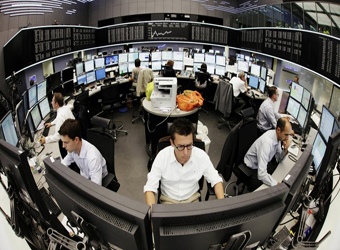European stocks reduced some of their earlier losses in afternoon trade Tuesday after tumbling 3 percent in the early hours of the session.
The pan-European Stoxx 600 closed provisonally 2.28 percent lower with every sector in the red. Banks and insurance stocks were among the most impacted by the sell-off, down by more than 2.7 percent for the day.
The FTSE 100 closed down 146 points, or 2.42 percent at 7157. It had earlier hit a one-year low, by shedding 255 points at the open.
Overall, there was a sea of red across the European benchmark with only a handful of companies trading above the flatline.
Austria Microsystems was a rare bright spot, rising 13 percent on the day. The Apple supplier said that an investment partner agreed to fund 25 percent of its planned $600 million spending this year, Reuters reported.
BNP Paribas reported a worse than expected net profit for its fourth quarter of 2017, falling 1.1 percent to 1.43 billion euros ($1.77 billion) and missing market expectations. The stock fell 3.26 percent across the session. 
Swedish lender Swedbank reported a higher-than-expected increase in fourth-quarter operating profits, thanks to higher commissions and interest income, Reuters reported.
At the same time, BP posted earnings above expectations on a surge in refining and trading during the final three months of 2017. Shares ended off by 1.2 percent.
In other market news, the Velocity Shares Daily Inverse VIX Short-Term exchange-traded note (XIV)- a security issued by Credit Suisse, fell more than 80 percent in extended trading on Monday.
Credit Suisse said in a statement that ”the XIV ETN activity is reflective of today’s market volatility. There is no material impact to Credit Suisse.” Nonetheless, the stock was one of the worst-performing banks Tuesday, ending down by more than 6 percent.
On Monday, the Dow Jones industrial average dropped 1,175.21 points to close down at 24,345.75. This built on losses recorded Friday.
After those two consecutive sell-offs, U.S. stocks were all over the map on Tuesday.
The Dow Jones industrial average opened with a slump lower, then rallied all the way back and was more than 300 points higher at one point, before settling back down.
As of 11:22 am ET, the Dow was 80 points lower. At its extremes, the market average was down by 567 points and higher by 367 points.
Despite the ongoing sell-off, many managers were not panicking just yet.
“We’re not panicking, it’s obviously going to be a very bloody day on market,… but I have confidence in the portfolio,” Eric Moore, income fund manager at Miton Group told CNBC Tuesday morning.
“Nothing that has happened over the last 48 hours has made me think that the dividend characteristics of my portfolio are worse than I thought before,” he said.
Moore added that the economic fundamentals remain okay and the current sell-off feels like a technical correction after the several record highs registered in the past year.
Salman Ahmed, chief investment strategist at Lombard Odier, also downplayed the current sell-off. He told CNBC on Tuesday: “If the correlation between bond yields and equities switches, so if yields start to go up at the same time as equity becomes under pressure, then we will have to reassess our whole paradigm.”
Source: CNBC


